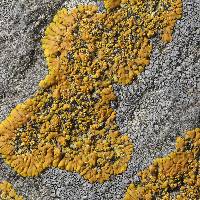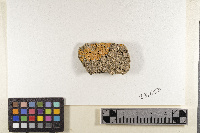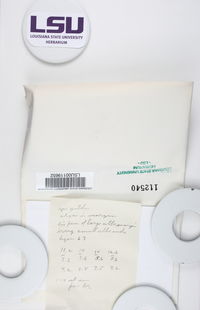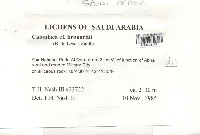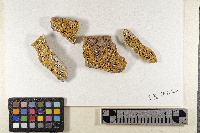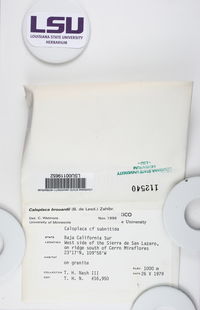
- Home
- Search
- Images
- Species Checklists
- US States: O-Z >
- US National Parks
- Central America
- South America
- US National Parks
- Southern Subpolar Region
|
Wetmoreana brouardii (B. de Lesd.) Wilk & Søchting
 (redirected from: Caloplaca brouardii (B. de Lesd.) Zahlbr.) (redirected from: Caloplaca brouardii (B. de Lesd.) Zahlbr.) |
|
|
Family: Teloschistaceae
[Caloplaca brouardii (B. de Lesd.) Zahlbr., moreCaloplaca brouardii var. brouardii (B. de Lesd.) Zahlbr., Fulgogasparrea brouardii (B. de Lesd.) S.Y. Kondr., Placodium brouardii B. de Lesd.] |
MB#836904 Basionym: Placodium brouardii B. de Lesd., Lich. Mexique 11. 1914; MB#401030. Description. Thallus placodioid, of ± isodiametric, angular, convex areoles in the center and shortly elongated, moderately convex to broadly flattened, ~0.3 mm broad lobes along the periphery, individual thalli up to 3 cm in diam., but several thalli frequently confluent, merging with one another; hypothallus and prothallus absent; surface smooth to dull, not shiny, orange to deep orange, epruinose or, especially on the marginal lobes, with pale orange, farinose pruina; central areoles strongly papillate; papillae granular-globose, ~0.2 mm in diam., apically often breaking apart to extrude coarse, blastidiate soredia, (27–)28–41(–42) μm in diam. Apothecia not seen. Pycnidia not observed. Chemistry. Thallus P–, K+ purple, C–, KC± purplish (fading), UV– (dull); with dominant parietin and smaller proportions of fallacinal together with traces of teloschistin, parietinic acid and emodin. In some specimens the thallus contains significant proportions of the depsidones isofulgidin and vicanicin. This corresponds to chemosyndrome A3+2 sensu Søchting & Frödén (2002) and is the same as found in specimens from Baja California. Ecology and distribution. Africa, North and South America (Brazil, Guatemala, Peru; see Wetmore & Kärnefelt 1998). It is new to Ecuador and the Galapagos, where the species is only moderately common, growing on rock in sheltered to ± exposed habitats throughout the transition zone, less frequently also in the humid zone. Notes. The specimens from Galapagos are morphologically indistinguishable from specimens from the Sonoran Desert, but the few analyzed specimens may suggest the Galapagos material to represent a separate genotype. More material from the American continents is needed Nash, T.H., Ryan, B.D., Gries, C., Bungartz, F., (eds.) 2007. Lichen Flora of the Greater Sonoran Desert Region. Vol 3. Life habit: lichenized Thallus: crustose, areolate to elongate lobed, lobes 0.5-1.5 mm long, 0.3-0.5 mm wide; prothallus: absent surface: orange, smooth, isidiate isidia: short, globose to papillate, not branched, laminal cortex: cellular, moderate, 14-30 µm thick, granules absent; medulla paraplectenchymatous, without granules Apothecia: adnate, 0.3-0.5 mm in diam., lecanorine disc: orange, flat, epruinose margin: persistent, flush; thalline margin present, concolorous with thallus; proper margin not visible parathecium: cellular (paraplectenchymatous) including exciple below hypothecium epihymenium: golden, K+ red, H-, 10%N-, cN-, C- hymenium: hyaline, 60-65 µm tall paraphyses: not swollen or 1-2 tip cells slightly swollen, with few branches; subhymenium hyaline asci: cylindrical, 8-spored ascospores: hyaline, 2 locules, ellipsoid, 11-14 x 5.5-7 µm, isthmus 3.5-4 µm, spore end wall thin Pycnidia: present, totally immersed, ostiole orange Spot tests: apothecial margin K+ red, H-, 10% N-, cN-, C-;thallus K+ red, H-, 10%N-, cN-, C-; medulla IKI- Secondary metabolites: parietin, fallacinal, emodin, and teloschistin. Substrate and ecology: on non-calcareous rocks World distribution: Africa, North and South America Sonoran distribution: Arizona, Baja California Sur, western Chihuahua, Sonora, and northern Sinaloa. Notes: Caloplaca brouardii has orange rather narrow flattened lobes with the central portions covered by numerous small papillae. The lobes are closely appressed to the rock. Caloplaca texana has longer lobes that are convex and often somewhat lighter color and pruinose at the tips and the center of the thallus has phyllidia. Caloplaca appressa has longer lobes and no phyllidia or papillae. |





